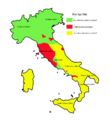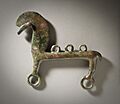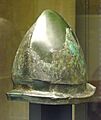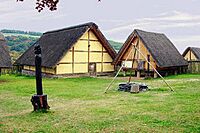Iron Age Europe facts for kids
The Iron Age in Europe was a really important time. It was the last part of the prehistoric period, meaning before written history was common everywhere. It also marked the start of "protohistory" in some places, which is when ancient Greek and Roman writers started describing certain areas.
During this period, people learned to work with iron, a strong metal that changed everything! Iron working came to Europe around 1100 BC, likely from the Caucasus region. It slowly spread across the continent over about 500 years. For example, in Ireland, the Iron Age began around 500 BC and lasted until about 400 AD. Iron tools and weapons became very common in both Europe and Asia.
The start of the Iron Age also brought new cultures. In Central Europe, the Urnfield culture was replaced by the Hallstatt culture. In northern Italy, the Villanovan culture began, which led to the Etruscan civilization. The Hallstatt culture, and later the La Tène culture, are often linked to the Celts.
Iron Age items, like weapons and tools, had more detailed designs than before. Instead of being cast (poured into a mold), they were hammered into shape. The decorations became more curvy and complex.
Contents
Timeline of the Iron Age

-
-
- Dates are approximate, consult particular article for details
- Prehistoric (or Proto-historic) Iron Age Historic Iron Age
-
Eastern Europe
The Iron Age in Eastern Europe started around 1000 BC. In the Pontic steppe and Caucasus areas, it began with the Koban culture and Novocherkassk culture around 900 BC. By 800 BC, ironworking spread to the Hallstatt culture further west.
In ancient Russia and Ukraine, the Iron Age is strongly connected to the Scythians. They developed iron culture from the 7th century BC. Many remains of their iron production and blacksmithing were found near Nikopol. This area is thought to have been a major metalworking center for ancient Scythia.
For the Balts, who lived from the Vistula Lagoon to the Oka River, the Old Iron Age brought huge changes. Around the 1st century AD, they started making iron from limonite, a type of iron ore found in swamps. Local smiths learned to turn iron into steel. This made their weapons much stronger than older tools made of stone or horn.
Southeast Europe
The Greek Dark Ages (around 1200 BC to 800 BC) saw many iron weapons. During this time, the palace centers of the Mycenaean culture were abandoned or destroyed. By 1050 BC, their unique cultural features, like the Linear B script, had disappeared.
The Greek alphabet began in the 8th century BC. It came from the Phoenician alphabet. The Greeks added vowels, creating the first true alphabet. As Greece sent settlers across the Black Sea and to Italy, their alphabet spread. An old Greek pot from around 730 BC, found in Italy, has writing that mentions "Nestor's Cup". This seems to be the oldest written reference to the Iliad.
Later, in Southeastern Europe, groups like the Thracians and Dacians formed large tribal unions. The Odrysian kingdom was a powerful Thracian kingdom in the 5th century BC.
Central Europe
In Central Europe, the Iron Age is split into two main parts. The early Iron Age is the Hallstatt culture (800–450 BC). The late Iron Age is the La Tène culture, which started around 450 BC.
The change from bronze to iron can be seen at the large cemetery in Hallstatt. Here, tools and weapons from the late Bronze Age were copied in iron. But in the La Tène culture, the tools and weapons had completely new designs.
Celtic culture spread across much of Central Europe. After the Gallic invasion of the Balkans in 279 BC, they even reached central Anatolia. In Central Europe, the prehistoric Iron Age ended when the Romans conquered these areas.
From the Hallstatt culture, the Iron Age moved west with the Celtic expansion from the 6th century BC. In Poland, the Iron Age reached the late Lusatian culture around the 6th century BC.
Italy
-
Incineration and inhumation in Iron Age Italy
-
Villanovan Tomb from the 9th century BC. Museo Guarnacci, Volterra.
-
Bronze Harness Trapping in the Shape of a Horse; Villanovan, 9th–8th century BC. LACMA.
In Italy, the Iron Age likely began with the Villanovan culture. This culture followed the Bronze Age Proto-Villanovan culture in Tuscany and northern Latium. It also spread to other parts of Italy. The Villanovan culture buried cremated remains in special double-cone shaped urns.
The Etruscans used an alphabet that spread throughout Italy from the 8th century BC. The Etruscan Iron Age ended when the Roman Republic grew powerful and conquered the last Etruscan city in 264 BC.
On the island of Sardinia, iron working seems to have started around 1300–1000 BC with the Nuragic civilization.
Western Europe
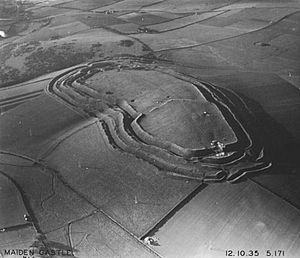
-
Greek krater imported to southern France around 500 BC
-
German La Tène settlement reconstructed
-
Detail of the Battersea Shield from London
Celtic culture also spread to the British Isles and Iberian Peninsula. In the British Isles, the British Iron Age lasted from about 800 BC until the Roman Conquest. In areas not conquered by Rome, it continued until the 5th century AD.
Impressive structures were built during this time, like the brochs and duns in northern Scotland. Large hillforts were also common across the islands. On the Iberian Peninsula, special writing systems called Paleohispanic scripts were used from the 7th to the 1st century BC.
In 2017, an amazing discovery was made in Pocklington, England. A Celtic warrior's grave, dating from about 320 to 174 BC, was found. Archaeologists found a bronze shield, parts of a chariot, and the skeletons of ponies. The shield's design was unique, unlike any other Iron Age finds in Europe. Finding horses in Iron Age burials was rare, making this discovery very important.
Northern Europe
The early Iron Age in Scandinavia shows no signs of Roman influence. However, Roman influences became common later in the period. The last part of the Iron Age in Scandinavia was the Viking Age, from 700 to 1000 AD. This was when Christianity replaced the old pagan beliefs.
North of the Rhine River, beyond the Celts and Romans, the Iron Age is divided into the Pre-Roman Iron Age and the Roman Iron Age. In Scandinavia, other periods followed, including the Migration Period, the Vendel Period, and the Viking Age. The Jastorf culture dominated the earliest Iron Age in northwestern Germany and southern Jutland.
Early iron production in Scandinavia often used bog iron, which is found in swamps. Scandinavia, Finland, and Estonia had advanced iron production from about 500 BC. They also used ironsand, another type of iron ore.
Farming and Forests
The Iron Age brought big changes to farming. In Southern Europe, forests were mostly open evergreen and pine trees. After farmers used "slash and burn" methods (cutting and burning trees to clear land), these forests didn't grow back easily. In Northern Europe, forests grew back better, but farmers could usually only get one crop before grass took over.
Because of this, slash and burn farming stopped earlier in the south. Many Mediterranean forests were gone by Roman times. Ancient writers mentioned that the Mediterranean used to have more forests, but much had already been lost.
Europe remained heavily forested, especially in the north. However, during the late Roman Iron Age and early Viking Age, forest areas in Northern Europe greatly decreased. Settlements also moved often. This might have been because people were using up the land and forests.
New tools like iron plows appeared during this time. Early farmers liked good quality forest land on hillsides with good drainage. Traces of cattle areas are also found there.
The Greek explorer Pytheas visited Northern Europe around 330 BC. He described a fertile land called Thule, where the sun barely set in summer. He said the people there made a drink from honey and threshed grain in large houses because of the cloudy weather. They also moved their cattle to mountain pastures in summer. This description might fit the Norwegian coast, showing early dairy farming and indoor grain processing.
In Italy, shifting cultivation (moving farms often) was already ending by the time of Christ. The Roman Empire relied on farming from other areas. When these supplies decreased, the Roman Empire faced problems.
The Roman writer Tacitus wrote about the Germans in 98 AD. He said they didn't have private fields and moved their farms every year. They didn't try to get huge yields from the land, only grain. This shows they were still using shifting cultivation.
The Migration Period in Europe, after the Roman Empire, suggests that people in Central Europe found it easier to move to new forests when their old land was used up. This constant moving and forest use led to large areas being deforested. The forests in the Mediterranean suffered first because they didn't grow back as easily as the strong forests in Central Europe.
Many Italic tribes realized it was good to team up with the powerful Romans. When Rome built the Via Amerina road in 241 BC, the Faliscan people settled in cities on the plains and worked with the Romans. Over time, many Faliscan and Etruscan families became part of the Roman Senate. These Italic tribes became settled farmers.
See also
- Prehistoric Europe
- Bronze Age Europe
- Hallstatt culture
- La Tène culture
- Pre-Roman Iron Age
- Roman Iron Age
- Roman imperial period (chronology)
- British Iron Age


